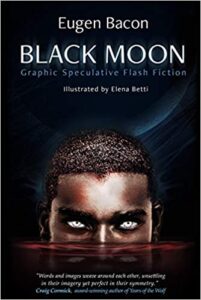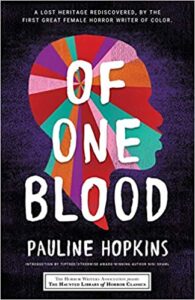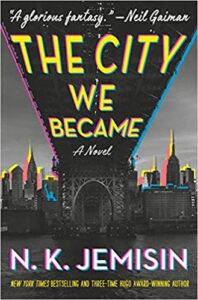Black Moon: Graphic Speculative Flash Fiction by Eugen Bacon, illustrated by Elena Betti
IFWG Publishing, 2020
ISBN: 978-1925956658
Available: Paperback ( Amazon.com )
With evocative illustrations and fabulous cover art by Elena Betti, the soft-hued blue pages of Black Moon by Eugen Bacon invite us to experience a pastiche of speculative poetry, prose, narratives and images. The titles of this collection of short pieces, such as “Cinders in Her Hair,” “Unlearning the Sea,” and “The Book of Unfinished Parables,” spark the imagination and tease the intellect. The widely diverse themes run from societal issues to personal experience and even fantasy. The tone varies from serious, to playful, to philosophical, to dark. Eugen clearly has eclectic interests and tastes and reveals them in an uninhibited, relatively unstructured fashion.
The poetic hybrids Eugen experiments with are definitely worth extra attention, but they seem to be in the middle of development. It is difficult to discern whether Bacon intentionally leaves the reader to her own devices in creating meaning in Black Moon or whether that effect is inadvertently caused by the writer’s artistic choices. Some of the pieces are quick snapshots of moments or ideas, but they do not include that particular magic of word choice or arrangement which little gems require. Other pieces are a bit longer and provide more context but seem unsatisfyingly without purpose or incomplete in some vague way.
Reading this book is like taking a stroll through a dream in which you recognize familiar objects but realize they are somehow out of context. It is also, at times, like reading a book in another language and trying to figure out a word you don’t know by comparing it to words that seem similar but end up having quite a different meaning. This abstract quality has its charm: eyes that are “serenading” and that are “shifting” “like an opal,” but sometimes it is just confusing: a window that “floundered” back to “her” house where she “locked herself to” tears.
Overall, Black Moon is a visual fusion that projects the author’s vision in such a way that the writer’s words become more concrete for the reader and the illustrations become more meaningful for the viewer. This is a natural synthesis that has the potential to evolve into a form that lovers of both poetry and art will enjoy.
Reviewed by Nova Hadley







Follow Us!